Location, Location, Location: Reflections on the Pilot Dance Project’s The Delicate Space
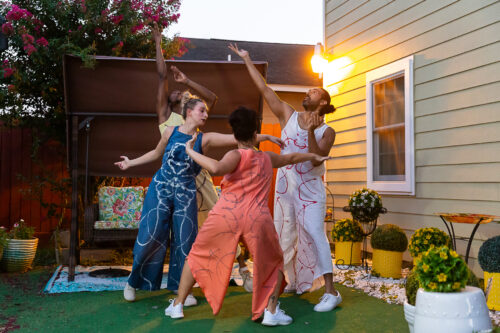
I. Physical Site
The Delicate Space took place in the yard of a house in north Houston, just inside the Loop. It is the home where Adam Castañeda, the artistic director of the Pilot Dance Project, grew up. This knowledge immediately lends weight to the production. Words like “childhood home” have emotional content that can be very different person to person.
The house sits on a corner lot and is two stories. The front yard is long and narrow, with only a few feet between the chain link yard fence and the front porch. We were directed past crepe myrtle and magnolia and a short pyramid of stacked, flat rocks, capped with a large planter full of artificial flowers, down the narrow passage between the side street and the house, past an exterior staircase to the second floor, which had a landing halfway up.
The backyard, where the majority of the performance took place, was mostly taken up by a driveway to a freestanding garage. There was a table with refreshments on the way to the seating area, a single row of chairs arranged in a U. The driveway itself was covered in artificial grass and a woven rug of some kind of plant fiber. Both grass and rug were pinned down on the edges by the seats. (I sat in a chair with my back to the open garage.)
The small area between the house and the garage was also covered in the artificial grass. The refreshment table faced this area.
I attended the Saturday, 7:30 p.m. performance. The sun was still bright and it was hot but not quite as severe as the immediately previous days had been.
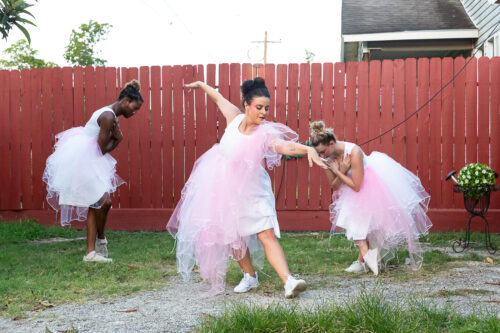
II. Performance as Site for Reflection
The performance, in a word, was lovely.
I’ll first say that there was no program that I saw, so I cannot give precise credit to many elements of the performance.
All the music used was recorded with stringed acoustic instruments in the foreground. It varied mostly in tempo, from lilting romanticism to bouncy jigs, but even at its most frolicsome, the strings maintained a dreamy softness throughout.
The costumes, constructed by Ashley Horn, also the main choreographer for the evening (Castañeda credited as guest choreographer), were mostly dresses in an array of muted pastels and floral prints. When the rare pair of pants made an appearance, they were also of pale floral prints. The costumes changed often but kept the faded, nostalgic feeling of the evening.
The pre-show press told us that the idea for this production originated with Horn, came to Castañeda with the idea of an evening of duets. Horn’s work is often marked with a sense of whimsy or the fantastic, and for The Delicate Space, that impulse manifests in a wistfulness and nostalgia. Castañeda’s “guest choreography” was used to provide segues between the duets, using up to five performers. Horn and Castañeda are longtime collaborators and their choreography melded seamlessly so that the whole performance flowed without any jarring stylistic jumps.
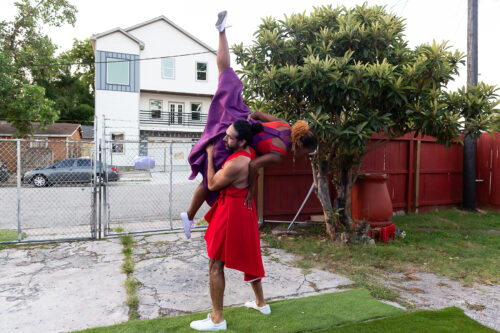
An early duet had a slight flavor of folk dance, danced to a lilting piece of music. It the duets were taking us on a journey of a single relationship, this was the happiest of the duets, like a memory of first flush of romance.
A memorable solo had a woman in a blue dress with long white gloves, trimmed at the biceps with flowers; a small headpiece made of matching flowers completed the look. I was captivated by the pantomime aspect of the choreography, as the dancer held one arm curved as if holding a basket or pan, the other arm gathered something—flowers came to mind. Otherwise, her movement was small and birdlike, her head occasionally bobbing like a pigeon. It was during this solo that I noticed that neighborhood birds were occasionally adding to the soundtrack with their chirps and tweets, an advantage of outdoor, quiet performances.
Another soloist moved around the seated audience, taking birdseed by the handful from a shoulder bag and depositing it at our feet. At the end of her section, the soloist pours birdseed down the length of her own arm. It was a ritual without clear meaning to me, but still felt fitting to the larger context of the evening.
There was a section that had the feel of a performance art installation. A woman sets down a pair of shoes on the driveway and takes a folded piece of paper from it. She reads an apology to someone who is, it becomes apparent, deceased. Other pairs of shoes are brought out by other dancers and set about the driveway space. It is evident some of them have notes in them, too. The shoes are all different styles, seven pair in all, one being a toddler’s shoes. The expectation I had was that other notes from shoes would be read but that didn’t happen.
Castañeda brings out one last pair of shoes, these holding plants. One held what I think are vincas in bloom, the other shoe held coleus. Castañeda danced a solo among the shoes. Informed by the note read just previous, I couldn’t help but feel the dance was a lament. The wide, expansive gestures alternating with closing, contracting motions seemed to be a physical manifestation of waves of grief or sadness.
A curious but welcome intermission of sorts came when one of the performers emerged from the house with a large platter loaded with varieties of pan dulce. With tongs in hand, she went about the audience offering the treats. (I chose the one with sprinkles because, of course, sprinkles.)
We were then invited to get up and move to the front of the house. As we passed the exterior staircase, a performer stood on the landing, singing “I Can’t Help Falling in Love With You” a capella. As the audience passed beneath her, she pulled pieces of laundry from a basket and shook out flower petals on us.
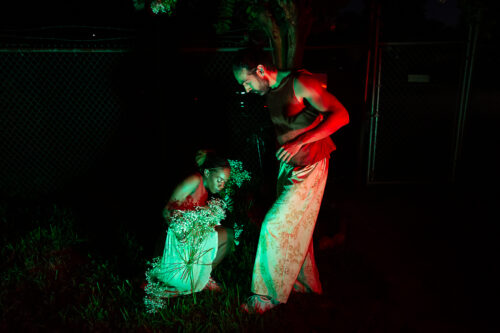
Once we were all in the front yard, the two “main characters” of the evening, the duet partners (Castañeda was one, I’m not sure of the name of the other—another place a program would have been helpful) enter in mahogany-colored tops and skirt and trousers of pale golden floral print material. (Editor’s note: The dancer’s name is Courtney Sherman-Allen.) The woman has a shoulder bag of small white flowers, I think baby’s breath. The man stands still, unresponsive to her every gesture. She tries to give him some of the flowers but he remains passive. Eventually, she shoves flowers to his chest and he briefly holds them, then lets them fall to the ground. He steps on them as he walks away. This gave me the strongest emotional response of the evening, being a terribly sad image.
Another solo takes place on the front porch. A figure in long, yellow skirts, again with pale floral print, and a crown of small yellow flowers and strings of pearls that drape over and under his arms, danced a somber but not hopeless choreography. There was something magical or ethereal about it.
The final section of the evening found our duet pair lying on the ground, baby’s breath on and around them. I could not help but think of a cemetery plot. They sit up and come to standing, partnering in a tender duet that ends with them picking up the baby’s breath and placing the flowers in each other’s hair before exiting around the far side of the house.
There were other sections but these give a sense of the evening. I found that, through the whole performance, I felt very aware of us being in Castañeda’s childhood yard and hence projected the duets as illustrating events that took place in this house and family. Then I had to remind myself that it was Horn’s choreography and so unlikely to be that closely autobiographical. Perhaps it’s a mixture of both. Perhaps it is ultimately none of my business.
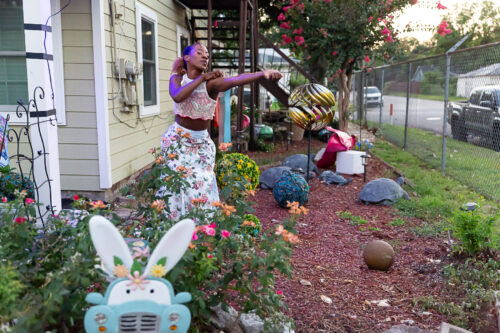
III. Audience as site
We were told as we entered that the performance would take place all around the yard and the audience would move with the performers. This is not that unusual for site-specific work and can even be expected.
I believe the performance might have been enhanced by some confident guidance for the audience. There was a section that took place in the space between the garage and the house, but it wasn’t immediately clear to the audience if we were to move there until it was well underway and then most everyone stayed in their seats anyway. I did get up from my seat to move across the driveway to confirm that the performance continued in that space, but I could not see much even after moving. My neighbors who stayed in their seats could not see any part of it. I started to take the initiative to move over to the second performance space but I had the same uncertainty of the rest of the audience—was that section going to go on long enough to make the move? And then I was uncertain if I did become a leader for the audience, would there be enough room for all of us without crowding the dancers?
Then when we moved to the front of the house, there was a moment of uncertainty again. Was the performance over and the dancers making an exit, or were we to follow? Finally, someone in the company told us to move, but it was an awkward transition.
I mention this for the benefit of any restaging of the work, but also for other performers considering using this model. Ushers are a useful role for making the audience secure in where to go, where to look. As it is, most of us missed an entire section of this performance.
IV. Conclusion
This is a longer review than usual, but this hour evoked many things for me and part of what I try to do is to help those who were there to relive the experience and those who weren’t an idea of what they missed. It really was a lovely, tender evening of dance.



Recent Comments